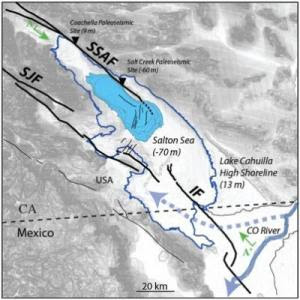Southern California's Salton Sea, once a large natural lake fed by the Colorado River, may play an significant role in the earthquake cycle of the southern San Andreas Fault and may have triggered large earthquakes in the past.
The Salton Sea covers a structural boundary at the southern end of the San Andreas Fault where it takes a southwestward step to the regal Fault.
 The region is closely monitored because the last large earthquake on this section of the San Andreas occurred roughly 300 years ago and the fault is measured by many experts to be overdue for another.
The region is closely monitored because the last large earthquake on this section of the San Andreas occurred roughly 300 years ago and the fault is measured by many experts to be overdue for another.
By imaging underneath the Salton Sea, the study recognized the key role of step over faults that run at an angle to the San Andreas Fault. The smaller faults break relatively frequently and, at times, they ruptured in concert with Colorado River flooding of the Salton Trough. Report lead author Danny Brothers said that this research does not improve the aptitude to predict such a quake but suggests that heightened preparedness for a major quake right away following smaller quakes in the step over zone is warranted.
"To fully appreciate the hazards and rupture scenarios connected with the southern San Andreas Fault, we can't limit our study to the San Andreas Fault itself," said Brothers, a researcher now at the USGS who conducted most of the research while a graduate student at Scripps. "These step over zones really need to be measured when assessing earthquake hazards and need to be examined as potential triggers for unhelpful earthquakes on the larger faults."
The Salton Sea covers a structural boundary at the southern end of the San Andreas Fault where it takes a southwestward step to the regal Fault.
 The region is closely monitored because the last large earthquake on this section of the San Andreas occurred roughly 300 years ago and the fault is measured by many experts to be overdue for another.
The region is closely monitored because the last large earthquake on this section of the San Andreas occurred roughly 300 years ago and the fault is measured by many experts to be overdue for another.By imaging underneath the Salton Sea, the study recognized the key role of step over faults that run at an angle to the San Andreas Fault. The smaller faults break relatively frequently and, at times, they ruptured in concert with Colorado River flooding of the Salton Trough. Report lead author Danny Brothers said that this research does not improve the aptitude to predict such a quake but suggests that heightened preparedness for a major quake right away following smaller quakes in the step over zone is warranted.
"To fully appreciate the hazards and rupture scenarios connected with the southern San Andreas Fault, we can't limit our study to the San Andreas Fault itself," said Brothers, a researcher now at the USGS who conducted most of the research while a graduate student at Scripps. "These step over zones really need to be measured when assessing earthquake hazards and need to be examined as potential triggers for unhelpful earthquakes on the larger faults."

No comments:
Post a Comment